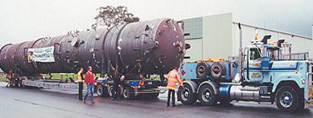
- (03) 5909 8218
- enquiry@fusionweld.com.au
What are CO2 Absorber Vessels?
June 28, 2017

Ammonia synthesis plants cover one end of an industrial park. Over in another corner, there's a chemical processing facility. It overlooks the coast, so you can see all the way down to the oil refinery that's being built over there. As you can see from all of these giant facilities, chemical processing technology exists everywhere. Among those meticulously engineered processing systems, CO2 absorber vessels are at work, but what exactly is their role in these systems?
What are CO2 Absorber Vessels?
Basically, these containment units capture carbon dioxide. If a flue gas stream contains substantial quantities of CO2 (carbon dioxide), the feed stream is funneled up through the vessel, at which point it reacts chemically with a special solvent. As one example, potassium carbonate is used to strip the CO2 from the gas stream, then several additional catalysing events take place as the hot solvent captures the unwanted gas and transforms it into pure CO2.
Deconstructing the Containment Technology
High-pressure stages and low-pressure chambers combine with solvent reservoirs to process the gaseous feed. A pressure differential builds between the stripping section and the absorber components, so the interior architecture within the unit must resist pressure transients, high temperatures, and all kinds of corrosive solvents. Now, small carbon dioxide vessels are used in life support systems, with their chemically-loaded interiors scrubbing CO2 from breathable air, but the equipment referenced here is built for applications that scrub much larger volumes of gas.
Dirty Gas Stream Applications
Any massive application that produces large volumes of carbon dioxide will benefit from the addition of a CO2 absorber vessel. A large coal-fueled power station is an obvious candidate here, as is a CO2 scrubbing unit inside an ammonia production plant. Otherwise, the greenhouse gas would float upward, unfettered and free to further corrupt the environment on a global scale. Installed at a flue output section, the CO2 scrubber uses its solvent-resistant innards to separate that greenhouse gas from feed streams and byproduct currents, then the cleaned gaseous remnants are further processed, recycled, or released. Incidentally, the recovered CO2 can be contained and sold for some other application.
Curiously, there are examples of CO2 scrubbers on submarines, spacecraft, and many other places where life support systems are required. However, the industrial strength processing equipment you've seen here adopts a somewhat more active solution, one that requires pressure vessels to endure when caustic solvents, high temperatures and higher pressure differentials are part of the process mix.
Contact Details
Fusion - Weld Engineering Pty Ltd
ABN 98 068 987619
1865 Frankston Flinders Road,
Hastings, VIC 3915
Ph: (03) 5909 8218
Optimized by NetwizardSEO.com.au
Recent Posts
- Compressed Hydrogen Storage Vessels: Material Selection, Design & Australian Standards
- Welding QA/QC in Oil & Gas Pressure Vessel Fabrication – Ensuring Code Compliance
- AS1210 vs ASME VIII Pressure Vessel Code: Key Differences for Australian Projects
- Mitigating Hydrogen-Induced Cracking in Pressure Vessels: Engineering and Material Strategies
- Storage Tank Solutions Australia: Field-Erected, Prefabricated & Self-Bunded Explained
- Reducing Environmental Risks: Self-Bunded Tanks in Australian Oil & Gas Operations
- Precision in Production: How Pressure Vessels Are Manufactured for Industrial Safety
- Shell & Tube Heat Exchangers: Improve Thermal Control & Energy Recovery in Petrochemical & Pharmaceutical Plants
- In-Service Inspection for Compressed Air Receivers for Power Plant Shutdown Prevention
- Power Plant Pipe Spooling Fabrication – Get Rapid, Code-Compliant Spools Ready for Installation
- Field Erected Tanks: Safe, Reliable On-Site Fuel Storage Solutions in Australia
- Custom Pressure Vessel Fabrication for Flammable Gases
Posts 2025
- Compressed Hydrogen Storage Vessels: Material Selection, Design & Australian Standards
- Welding QA/QC in Oil & Gas Pressure Vessel Fabrication – Ensuring Code Compliance
- View all articles…
Posts 2024
- Large Process Vessels: Optimising the Design for Maximum Efficiency [2025]
- Pressure Equipment Management System Installation: Detect Equipment Faults Early
- View all articles…
Posts 2023
- Pressure Piping System Inspection: A Gift of Safety for the Holidays
- Deaerator Inspections by Fusion-Weld Engineering and How They Reduce System Downtime
- View all articles…
Posts 2022
- How Fusion Weld Keeps Up With AS-NZS ISO 9001:2008 Standard
- Boiler Equipment Safety Inspection During the Summer Season
- View all articles…
Posts 2021
- Avoid These Factors and Practices that Contribute to Sealing Damage in Pressure Vessels
- Do's And Don'ts Of Industrial Boiler Inspection And Maintenance From Fusion-Weld
- View all articles…
Posts 2020
- What are the Risks and Hazards Involved in Pressure Vessel Equipment?
- How to Know if Your Pressure Equipment Needs Repair or Replacement?
- View all articles…
Posts 2019
- Factors that Contribute to Pressure Vessel Failure
- Pressure Vessel Regulations in Australia: What are the Mandatory Requirements?
- View all articles…
Posts 2018
- Pros and Cons of Spherical vs. Cylindrical Pressure Vessels
- What are the Different Hazard Levels in Pressure Vessels?
- View all articles…
Posts 2017
- Transportable Pressure Vessels: The Importance of Inspection and Safety Checks
- Fracture Mechanics and Stress Analysis of Cracks in Pressure Vessels
- View all articles…
Posts 2016
Posts 2015
- What Are Deaerators & Feedwater Vessels?
- Precautions and Safety for Compressed Air Receiver Vessels
- View all articles…
Posts 2014
- Demonstrating In-process Inspection Procedures
- Static Grounding Practices and Standards
- View all articles…